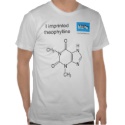|
|
Reference type: Journal
Authors: Courtois J, Fischer G, Schauff S, Albert K, Irgum K
Article Title: Interactions of bupivacaine with a molecularly imprinted polymer in a monolithic format studied by NMR.
Publication date: 2006
Journal: Analytical Chemistry
Volume: 78
Issue: (2)
Page numbers: 580-584.
DOI: 10.1021/ac0515733
Abstract: A trimethylolpropane trimethacrylate-based monolith of dimensions carefully chosen to fit exactly in a standard 4-mm solid-state CP/MAS NMR rotor was photopolymerized and subsequently molecularly imprinted with bupivacaine using a grafting protocol with methacrylic acid and ethylene dimethacrylate as monomers. As no crushing or grinding of the monolith was necessary, additional unspecific surface area was not created. This procedure ascertains that differences observed between imprinted and nonimprinted polymers are due only to graft imprinted surfaces and give therefore better results in NMR spectroscopy due to less unspecific interactions between analyte and monolith. This improves the comparability to chromatographic evaluations where uncrushed monolithic columns are also used. To track interactions between analyte and stationary phase, the saturation transfer difference (STD) technique was applied on the polymer in the suspended state using the same solvent as in the chromatographic evaluation. This relatively new NMR method has to our knowledge not been used on chromatographic materials before. By using STD NMR on pristine monoliths, it was possible to measure large differences between the imprinted or nonimprinted polymers and the analyte indicating significant differences in the interaction mechanisms. These could be directly correlated with retention differences observed in chromatographic evaluations.
Template and target information: bupivacaine
|


 I imprinted theophylline T-shirt
I imprinted theophylline T-shirt







 magenta MIPs mug
magenta MIPs mug







 I love MIPs mug
I love MIPs mug






